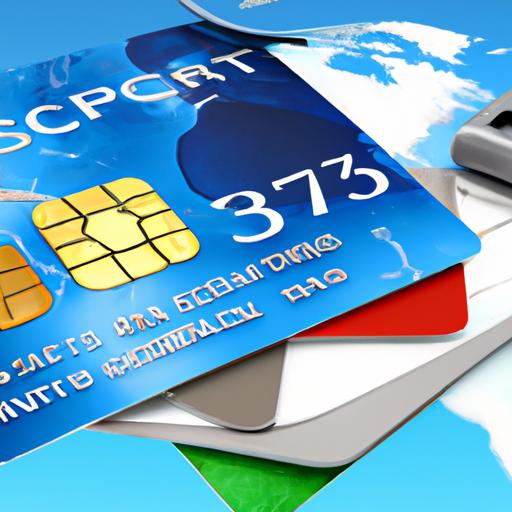Card Payments Industry Regulations and Compliance
Card Payments Industry Regulations and Compliance: Explaining industry regulations, PCI compliance, data protection laws, and how businesses can ensure compliance.
So, you’ve built your own little e-commerce empire, huh? That’s awesome! You’ve got your website set up, products stocked, and customers counting on you to give them a seamless and secure shopping experience. But hey, have you ever thought about the whole PCI compliance thing?
Wait, hold up! Don’t click away just yet. I know, I know, this whole compliance jargon can be boring and intimidating. But trust me, it’s crucial if you want your e-commerce business to thrive without any legal troubles or customer trust issues.
So, let’s break it down in plain English and explore some best practices for maintaining PCI compliance in your vibrant e-commerce world.
First and foremost, let’s talk about passwords. Yep, those pesky things that can be your best friend or your worst enemy. It might sound cliché, but strong passwords are like the bodyguards of your online kingdom. And please, don’t even think about using “password123” or “123456.” Seriously, what are you doing? Instead, opt for a mix of uppercase and lowercase letters, numbers, and special characters. And don’t forget to change them regularly – just like you change your hairstyle, you know?
Now that we’ve got the basics covered, let’s dive into encryption. You don’t need to be a math wizard to understand it, promise! Encryption is like your virtual invisibility cloak, protecting sensitive data from prying eyes. Make sure to use secure encryption methods like SSL or TLS to keep your customers’ payment information safe during transit. Trust me, they’ll love you for it.
Moving on, let’s talk about these fancy firewalls. No, we’re not discussing medieval battles here. But think of firewalls as the guardians of your e-commerce castle, keeping the bad guys at bay. A good firewall will help shield your website from malicious attacks and unauthorized access attempts. It’s like having an army of virtual knights protecting your digital treasures.
Speaking of protection, it’s crucial to keep your software up to date. Just like how you update your wardrobe with new trends, ensure that your e-commerce platform and payment gateway stay up to date with the latest security patches and bug fixes. Outdated software is like wearing bell-bottoms in the digital world – it’s not a good look and can leave you vulnerable to sneaky hackers.
Now, let’s talk about your team – your very own e-commerce Avengers. Train your staff in PCI compliance practices, for they are the first line of defense against any breaches. Teach them to recognize potential security threats and ensure they understand the importance of handling customer data with utmost care and confidentiality. Remember, teamwork makes the compliance dream work!
Last but not least, perform regular vulnerability scans and penetration tests. Think of it as a way to discover any weak spots in your e-commerce fortress before the wrong people do. Hire external security experts or use automated scanning tools to assess your system’s vulnerability, patch any loopholes, and ultimately sleep soundly knowing your e-commerce kingdom is secure.
So, there you have it – some creative, yet practical, best practices for maintaining PCI compliance in e-commerce. Keep these tips in mind, and your customers will love you for not only providing them with fantastic products but also for keeping their sensitive information locked away from the clutches of cyber criminals. Happy e-commerce ruling!
Mobile payment solutions have revolutionized the way we handle our financial transactions. Gone are the days of fumbling around for loose change or swiping our credit cards at checkout counters. With just a tap of our fingers, we can now purchase goods and services seamlessly. But while mobile payment solutions have made our lives easier, they have also raised concerns about data protection regulations.
In this digital era, data protection has become a paramount issue. With the increasing number of cyber threats and breaches, it is essential to ensure that our personal and financial information is kept secure. Mobile payment solutions, with their convenience and accessibility, have become a breeding ground for potential uncertainties.
To fully grasp the implications of mobile payment solutions on data protection regulations, we must first understand how they work. These payment solutions utilize near-field communication (NFC) technology, which allows two devices to communicate over short distances. When we tap our mobile phones on a payment terminal, the NFC technology facilitates the transfer of data, completing the transaction.
The concern lies in the security of this data transfer. Hackers and cybercriminals are constantly evolving, using innovative methods to steal sensitive information. With the increase in mobile payment usage, the potential for data breaches is a real and pressing issue. Therefore, it is vital for data protection regulations to adapt and keep up with these emerging technologies.
To address these concerns, several data protection regulations have been put in place. These regulations aim to ensure that consumer data is handled with utmost care and to hold organizations accountable for any breaches or mishandling of information. One such regulation is the General Data Protection Regulation (GDPR), implemented by the European Union. The GDPR mandates organizations to implement strict security measures, obtain explicit consent from users, and provide transparency regarding data handling practices.
Mobile payment solution providers must comply with these regulations and adopt robust security measures to protect user data. Encryption techniques, tokenization, and secure communication protocols are just a few of the measures that can be implemented to mitigate the risk of data breaches. Additionally, adopting a privacy-by-design approach ensures that data protection is embedded within the design and development of mobile payment solutions right from the start.
However, compliance with data protection regulations is not solely the responsibility of the solution providers. Consumers also play a vital role in safeguarding their data. By regularly updating their mobile devices, using strong and unique passwords, and refraining from sharing personal information in insecure networks, they can contribute to the overall protection of their data.
In conclusion, mobile payment solutions have undoubtedly transformed the way we make payments, but this convenience should not come at the expense of data protection. With the ever-evolving landscape of cyber threats, it is imperative for data protection regulations to keep pace with technological advancements. By striking a balance between convenience and security, we can ensure that mobile payment solutions harmoniously fit into data protection regulations, ultimately benefiting both consumers and businesses.
Do you remember the last time you paid for something using your card? Maybe it was a fancy dinner at that new restaurant or a spontaneous shopping spree. Whatever the occasion, one thing is for sure: card payment processing has become an integral part of our daily lives. But have you ever stopped to think about the complex system that ensures these transactions are secure and compliant?
Addressing common compliance challenges in card payment processing is no easy feat, but it’s one that businesses and financial institutions cannot afford to overlook. In an ever-evolving landscape of technology and cybersecurity threats, staying ahead of the game is crucial. So, let’s delve into the captivating world of card payment compliance challenges and explore some possible solutions.
One of the most pressing challenges faced by businesses today is data security. With the rise of online shopping and digital transactions, hackers are becoming increasingly adept at stealing sensitive customer information. This poses a significant threat not only to the affected individuals but also to the reputation and credibility of the businesses involved. Implementing encryption protocols and regularly updating security measures can go a long way in mitigating this risk.
Another hurdle that organizations encounter is navigating the complex web of regulations and standards. From PCI DSS (Payment Card Industry Data Security Standard) to GDPR (General Data Protection Regulation), compliance can often feel like an uphill battle. Staying up to date with the latest requirements and training employees accordingly is crucial in avoiding hefty fines and ensuring customer trust. Embracing automation tools and specialized software can greatly simplify this process, taking the burden off businesses’ shoulders.
We cannot discuss compliance challenges without acknowledging the notorious issue of chargebacks. These frustrating occurrences not only cost businesses substantial amounts of money but also damage their standing with payment processors. Adopting a proactive approach to managing chargebacks is essential, involving comprehensive record-keeping, prompt customer communication, and dispute resolution procedures. By doing so, businesses can not only recoup lost revenue but also prevent recurring chargebacks in the future.
Furthermore, the rapidly changing landscape of payment processing presents its own unique set of challenges. What was once considered innovative and compliant yesterday can become outdated and non-compliant tomorrow. Staying ahead of the curve requires continuous education and adaptability. By actively monitoring industry trends and embracing cutting-edge technology, businesses can position themselves as pioneers in the ever-evolving world of card payment processing.
Lastly, let’s not forget the impact of globalization on compliance challenges. As businesses expand their operations across borders, they must navigate a complex maze of regional regulations and cultural nuances. What might be deemed compliant in one country could be a violation in another. Establishing a solid understanding of each market’s requirements and enlisting the help of local experts can prove invaluable in successfully expanding businesses while maintaining compliance.
In conclusion, the realm of card payment compliance is an intricate and evolving landscape. From data security to chargebacks, businesses face an array of challenges that require creativity and adaptation. By implementing the right tools, keeping abreast of regulations, and embracing innovation, organizations can conquer these hurdles and ensure a smooth and secure card payment experience for all. So, the next time you swipe your card with a confident smile, remember the efforts made behind the scenes to make that transaction not only smooth but also compliant.
Are you tired of feeling like a high-wire performer with your payment card processing system? Don’t worry, we’ve got you covered! In this article, we’re going to deep dive into some creative risk management strategies that will help you achieve Payment Card Industry (PCI) compliance and give you peace of mind.
First things first, let’s talk about the importance of risk management. With data breaches happening left and right, it’s crucial for businesses to protect their customers’ payment card information. PCI compliance ensures that your systems are secure and up to standard, reducing the risk of unauthorized access or fraudulent activity.
Now, let’s get into the nitty-gritty of risk management strategies.
1. Regular security audits: Just like your annual health check-up, your payment card processing system needs regular audits to ensure it’s in top-notch shape. Conduct audits at least once a year to identify any vulnerabilities and address them promptly.
2. Encryption, encryption, encryption: If you haven’t heard this word enough, here it is again – encryption! Encrypting your customers’ payment card data ensures that even if it falls into the wrong hands, it’s useless without the decryption key. Implement strong encryption algorithms to keep your sensitive data safe and sound.
3. Employee education: Your employees, who handle payment card information, are your first line of defense. Provide them with regular training sessions on best practices for data security and PCI compliance. Educated employees are less likely to make mistakes that could expose your payment card systems to risk.
4. Multi-factor authentication (MFA): Gone are the days of simple passwords. Implement MFA to add an extra layer of security to your payment card systems. By requiring users to provide additional verification, such as a fingerprint or a one-time passcode, you minimize the risk of unauthorized access.
5. Regular system updates: Keep your payment card processing systems up to date with the latest software versions and security patches. Hackers are constantly evolving, and so should your defenses. Staying current will help protect you against emerging threats.
6. Incident response plan: Prepare for the worst-case scenario with a solid incident response plan. Establish step-by-step procedures for identifying, containing, and resolving any security breaches. The faster you respond, the less damage will be done.
7. Vendor management: If you work with third-party vendors for your payment card processing, make sure they are PCI compliant as well. Regularly review your contracts and ensure that their security measures align with your risk management strategies.
So, my friends, it’s time to take the tightrope out of your payment card processing. Implement these risk management strategies and breeze through your PCI compliance audits. Remember, protecting your customers’ data is not only mandatory but also builds trust and credibility with your audience. Happy risk management!
Running a small business is like climbing a magical ladder with a sign that reads, “Success awaits you!” You take those tiny steps, dream big dreams, and envision a booming enterprise. But, hold on! As you strive to conquer this ladder, one wrong move can make it crumble beneath you. And no, we’re not talking about a faulty step, but the infamous Payment Card Industry (PCI) compliance.
PCI compliance is like the Big Bad Wolf standing in the way of your small business fairy tale. Now, you may be wondering, “What in the world is PCI compliance?” Well, my friend, it’s the set of standards that ensure your customers’ credit card information remains safe when they make a purchase from your business.
But worry not, for I am here to guide you through the labyrinthine forest of PCI compliance. Picture us as Hansel and Gretel, hand in hand, venturing forth to triumph over this menacing challenge.
First off, it’s crucial to comprehend the types of small business classifications regarding PCI compliance. You see, just like there are different shades of gray, small businesses can be classified into four categories: merchant level 4, merchant level 3, merchant level 2, and merchant level 1. Sounds like Hogwarts houses, right?
Merchant level 4 is the home of small businesses that handle fewer than 20,000 transactions annually. The merchant level 3 is similar, but their transaction volume lies between 20,000 and 1 million. As we ascend further, we arrive at the merchant level 2 – businesses processing 1 to 6 million transactions. And finally, the merchant level 1 is reserved for the mighty, processing over 6 million transactions annually. Can you feel the power?
After establishing your small business’s level, it’s time to put on your armor, gather your tools, and prepare for battle. The first weapon in your arsenal is to ensure that your payment systems are protected from external threats and have adequate firewalls in place. It’s like building a magnificent fortress to safeguard the kingdom from cunning invaders.
Next, small business warriors should never underestimate the power of encryption. It’s like a magical cloak that conceals your customers’ credit card information within a cocoon of algorithms and jargon. Incorporating encryption mechanisms such as secure sockets layer (SSL) certificates will keep the seas of hackers at bay.
Remember, it’s not just about building defenses; you must also monitor your fortress continuously. Regularly reviewing your security measures and implementing updates and patches is vital. It’s like reinforcing your castle gates to withstand a fearsome battering ram. Vigilance is key!
PCI compliance is not a one-time affair; it’s a lifelong journey. Warriors, brace yourselves for the next challenge – conducting regular vulnerability scans on your payment systems. It’s like scouting your kingdom’s borders for any potential chinks in your armor. These scans identify vulnerabilities that may lead to breaches, giving you a chance to fix them before the enemy strikes.
As we venture deeper into the labyrinth of PCI compliance, we stumble upon the importance of access control measures. Limiting employee access to cardholder data is like guarding the sacred secrets of your kingdom. Not everyone can be trusted with such crucial information. But fear not, for implementing strong passwords, two-factor authentication, and access control policies will keep your treasures hidden from prying eyes.
Lastly, dear small business warriors, we must discuss the need for comprehensive security policies and employee education. It’s like writing the laws of your kingdom, instructing everyone on how to protect the realm. Educating your employees about the dangers of phishing emails, social engineering tactics, and the importance of data security will make them the guardians of your castle.
So, my fellow small business adventurers, remember that achieving PCI compliance is like embarking on an epic quest. But fear not, for armed with knowledge and determination, you shall emerge victorious. Take these steps, conquer the Big Bad Wolf, and transform your small business fairy tale into a legendary saga of success!
The cyber world is a labyrinth of information, and in its tangled depths resides the Payment Card Industry Data Security Standard (PCI DSS) – a fancy title that might leave you scratching your head. Fear not, fellow intrepid explorer of the digital realm, for I am here to demystify this cryptic notion for you!
Think of PCI DSS as the guardian of your plastic pal, your trusted card that allows you to dance with financial freedom. It’s a set of rules, standards, and guidelines that the payment card industry has in place to safeguard your precious personal data. Like a fearless knight standing between you and the nefarious hordes of cyber criminals, PCI DSS ensures that your card information is protected from the digital goblins lurking in the shadows.
Now, let me break it down for you in simpler terms. Picture your card as a juicy piece of steak, and PCI DSS as the impenetrable forcefield that shields it from the ravenous jaws of cyber thieves. Just as a gourmet chef meticulously prepares your steak, so too does the payment card industry work diligently to keep your information safe from prying eyes. From the moment you swipe that card to pay for your midnight pizza cravings, PCI DSS swoops in, safeguarding each byte of data that zips through the intricate web of the payment process.
So how does PCI DSS work its magic, you may wonder? Well, it’s like having a digital babysitter, making sure that every party involved in handling your payment is complying with the highest security standards. From the merchant who accepts your card, to the payment processor who whisks the information to the bank, every link in the chain is held accountable. They must adhere to the PCI DSS commandments, guarding your card data as if it were their own.
But what if the unthinkable happens, and your trusty card happens to fall into the wrong hands? Worry not, brave consumer, for PCI DSS has got your back! It ensures that if a breach occurs, the appropriate parties are alerted, and swift action is taken. These standards prevent card information from becoming a gold mine for cyber villains, minimizing the chances of fraudulent activity affecting your financial well-being.
So, next time you whip out your card to make a purchase, remember that PCI DSS is working tirelessly behind the scenes, silently ensuring that your information is guarded with the utmost care. It’s your cyber bodyguard, your digital vigilante, and your knight in shining armor. So go forth, fearless spender, and rest easy knowing that the Payment Card Industry Data Security Standard has got you covered in the vast and mysterious world of the digital realm!







